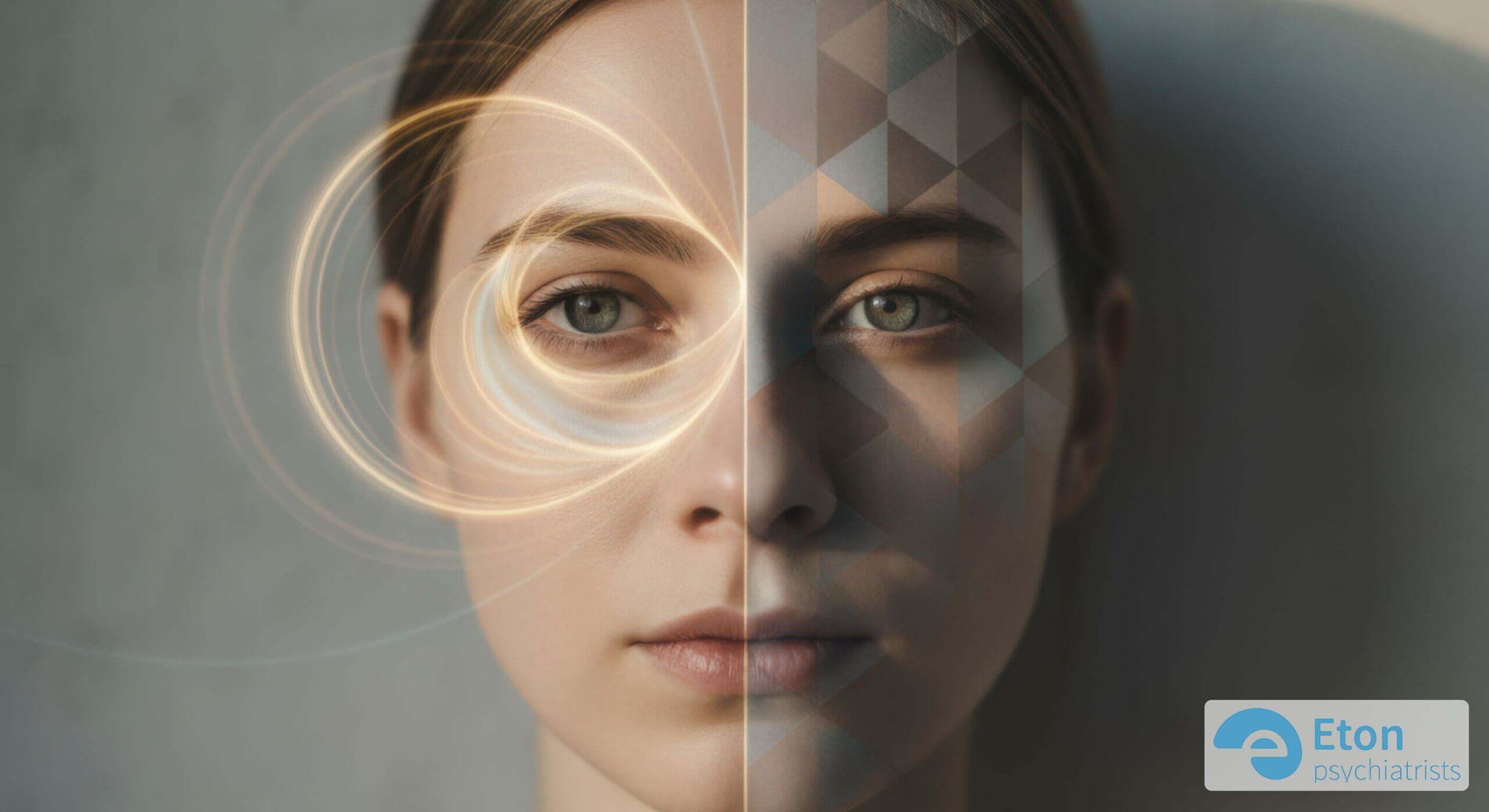
Living in Duality: Navigating Life with ADHD and Autism
Listen to the Article
For those on the go or who prefer listening, you can play the full audio version of this deep dive below.

What happens when the neurodevelopmental paths of ADHD and Autism intersect within one person? The result is a unique, often complex, internal experience that the neurodiversity community has termed “AuDHD.” While not a formal clinical diagnosis in itself, AuDHD meaning captures the lived reality of navigating the world with the combined traits, strengths, and challenges of both Attention Deficit Hyperactivity Disorder and Autism Spectrum Condition. Living with ADHD and Autism presents a constant internal duality, a push and pull between seemingly contradictory needs and ways of processing the world. Understanding this ADHD Autism overlap is crucial, not just for clinicians providing support, but for individuals seeking self-understanding and validation.
Table of Contents
- What is AuDHD? Decoding the Term
- ADHD and Autism Comorbidity: The Clinical Reality
- The Internal Contradiction: Core AuDHD Experiences
- Executive Function and Sensory Processing in AuDHD
- The Reality of AuDHD Burnout
- AuDHD in Women: Masking and Misdiagnosis
- Navigating Diagnosis: Assessing Both Conditions
- Strategies for Living with AuDHD
- Why Trust Eton Psychiatrists?
- Summary
- Sources
- Frequently Asked Questions
What is AuDHD? Decoding the Term
AuDHD is a community-created term blending “Autism” and “ADHD.” What is AuDHD? It describes the experience of individuals who are formally diagnosed with both conditions or strongly identify with the traits of both. It acknowledges that having autism plus adhd results in a distinct neurotype, where the characteristics of each condition interact and influence one another in complex ways. It’s not simply having two separate sets of symptoms side-by-side; it’s about how those symptoms combine and sometimes conflict, creating a unique profile.
ADHD and Autism Comorbidity: The Clinical Reality
Clinically, the co-occurrence of ADHD and Autism is known as comorbidity. For a long time, diagnostic manuals suggested these conditions couldn’t co-exist, but this is now recognised as incorrect. Current research indicates a significant ADHD and autism comorbidity rate. Studies suggest that a substantial percentage of autistic individuals also meet the criteria for ADHD, and vice versa. This clinical recognition validates the experiences described by the AuDHD community. The underlying reason for this overlap likely lies in shared genetic factors and similar patterns of neurodevelopment affecting brain regions responsible for executive function, attention, and social processing.
The Internal Contradiction: Core AuDHD Experiences
Living with AuDHD often feels like managing a series of internal contradictions. Individuals frequently describe a push-and-pull between opposing needs and tendencies:

- Routine vs. Novelty: The autistic need for predictability, routine, and sameness often clashes with the ADHD brain’s craving for novelty, stimulation, and change. This can lead to feeling simultaneously bored by routine yet distressed when it’s disrupted.
- Hyperfocus vs. Distractibility: While both conditions involve differences in attention regulation, AuDHD can mean experiencing intense, autistic hyperfocus on a special interest, only to be easily derailed by ADHD-driven distractibility or the pull towards a new, fleeting interest.
- Social Approach vs. Avoidance: An individual might experience the ADHD trait of impulsively wanting social connection, talking excessively, or seeking interaction, while simultaneously grappling with autistic social anxiety, difficulty interpreting cues, or becoming quickly overwhelmed and needing withdrawal.
- Impulsivity vs. Rigidity: The ADHD tendency towards impulsive decisions or actions can conflict with the autistic preference for planned, predictable behaviour and difficulty with cognitive flexibility.
These internal conflicts are central to the AuDHD experience and can be confusing and exhausting to manage.
Executive Function and Sensory Processing in AuDHD
Both ADHD and Autism impact executive functions, but often in interacting ways. AuDHD symptoms related to executive function can be particularly pronounced:

- Task Initiation & Paralysis: The ADHD difficulty starting tasks can be amplified by autistic inertia or demand avoidance, leading to profound task paralysis.
- Planning & Organisation: Both conditions affect planning, but the AuDHD combination might result in meticulously detailed plans (autistic trait) that are constantly disrupted by distractibility or abandoned for new ideas (ADHD trait).
- Sensory Input & Focus: Sensory sensitivities common in autism can make focusing even harder for the ADHD brain. Conversely, the ADHD need for stimulation might lead to seeking sensory input that then becomes overwhelming from an autistic perspective.
The Reality of AuDHD Burnout
The constant internal conflict, the high energy demands of masking traits from both conditions, and the challenges of navigating a neurotypical world often lead to a specific and intense form of burnout known as AuDHD burnout. This state goes beyond typical tiredness; it involves profound exhaustion, increased sensitivity, loss of executive function, heightened emotional reactivity, and often a temporary inability to mask, leading to more visible autistic or ADHD traits.

Understanding AuDHD burnout requires recognising the dual load. Individuals are managing not just social camouflaging but also the internal battle between conflicting neurological drives. Recovery often requires significant rest, reduced demands, sensory regulation, and self-compassion.
AuDHD in Women: Masking and Misdiagnosis
AuDHD in women presents additional layers of complexity. Both ADHD and Autism are historically underdiagnosed in females. Women often develop sophisticated masking techniques to hide both their autistic and ADHD traits, driven by societal pressures to appear socially adept, organised, and emotionally regulated. This intense, multi-layered masking makes diagnosis incredibly challenging and significantly increases the risk of burnout and co-occurring mental health conditions like anxiety and depression. Clinicians assessing women need specific expertise in recognising the subtle presentations of both conditions and understanding the impact of masking.
Navigating Diagnosis: Assessing Both Conditions
Can you have both ADHD and Autism? Yes. Obtaining a formal diagnosis requires a comprehensive assessment that specifically evaluates criteria for both conditions. It is vital to choose clinicians or clinics with expertise in diagnosing both ADHD and Autism, as well as experience with co-occurring presentations. A thorough assessment will involve:
- Detailed developmental history interviews.
- Clinical observation.
- Standardised questionnaires for both ADHD and Autism.
- Careful consideration of how traits interact and overlap.
Being diagnosed with ADHD and autism provides validation and allows for the development of integrated support strategies that address the unique interplay of traits.
Strategies for Living with AuDHD
Living with AuDHD involves finding personalised strategies that honour both the ADHD and autistic aspects of one’s neurotype. This might include:
- Structured Flexibility: Creating routines that provide autistic predictability but include built-in flexibility or novelty to satisfy ADHD needs.
- Sensory Regulation Tools: Proactively managing sensory input to prevent autistic overwhelm, which can improve ADHD focus.
- Energy Management: Recognising the high energy cost of masking and internal conflict, and scheduling regular downtime to prevent burnout.
- Interest-Driven Motivation: Leveraging autistic special interests or ADHD hyperfocus to tackle necessary but less engaging tasks.
- Self-Compassion: Acknowledging the inherent challenges of the AuDHD experience and practicing self-kindness during difficult moments.
Why Trust Eton Psychiatrists?
At Eton Psychiatrists, we specialise in the complex assessment and support of adults with neurodevelopmental conditions. Our experienced clinicians possess deep expertise in diagnosing both ADHD and Autism, including co-occurring presentations like AuDHD. We understand the nuances, the internal conflicts, and the impact of masking. Our NICE guideline compliant assessments are thorough and validating, providing the clarity needed to understand your unique neurotype and develop effective, personalised strategies for living with adhd and autism.
Summary
- AuDHD Defined: A community term for individuals with co-occurring ADHD and Autism, describing the unique experience of navigating traits from both conditions.
- Clinical Comorbidity: ADHD and Autism frequently co-occur due to shared neurodevelopmental origins and genetic factors.
- Internal Conflict: Living with AuDHD often involves managing contradictory needs, such as the desire for routine vs. novelty, or social approach vs. avoidance.
- Compounded Challenges: Executive function difficulties and sensory processing differences from both conditions interact, often intensifying challenges like task paralysis and overwhelm.
- AuDHD Burnout: A profound state of exhaustion resulting from the high energy demands of managing internal conflicts and masking traits from both conditions.
- Accurate Diagnosis is Key: Requires assessment by clinicians expert in both ADHD and Autism, capable of understanding their complex interplay, especially when masked.
Sources
Frequently Asked Questions
Can you have both ADHD and Autism?
Yes, absolutely. It is clinically recognised that ADHD and Autism Spectrum Condition frequently co-occur (comorbidity). Individuals diagnosed with both often use the term AuDHD to describe their experience.
What does AuDHD feel like?
It often feels like an internal contradiction or tug-of-war. Common experiences include craving routine but getting bored easily, wanting social connection but feeling overwhelmed quickly, being able to hyperfocus intensely yet struggling with distractibility, and experiencing both impulsive urges and rigid thinking.
Is AuDHD burnout different from regular burnout?
Yes, AuDHD burnout tends to be more profound. It stems not only from external pressures and masking (common in autistic burnout) but also from the constant internal conflict between competing ADHD and autistic needs and traits, leading to a deeper level of exhaustion and skill regression.
How do you get diagnosed with AuDHD?
AuDHD itself isn’t a formal diagnosis, but you can be diagnosed with both ADHD and Autism Spectrum Condition. This requires a comprehensive assessment by clinicians experienced in both conditions, evaluating criteria for each and understanding how they interact. Separate assessments for each condition might be needed, or an integrated assessment covering both.



